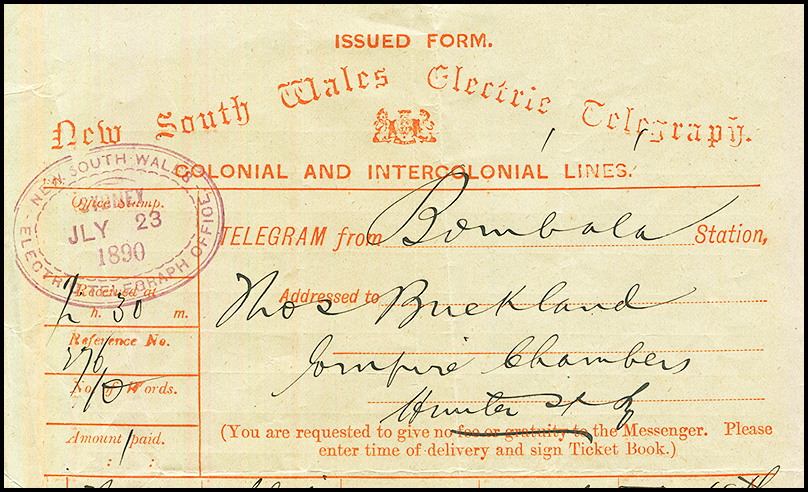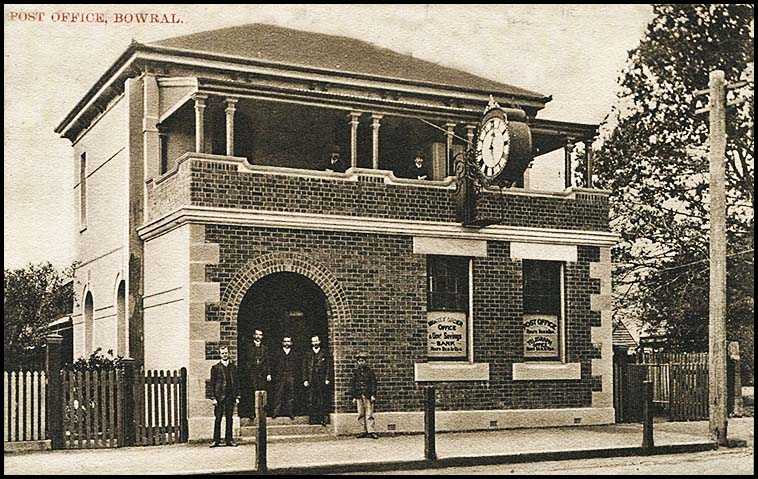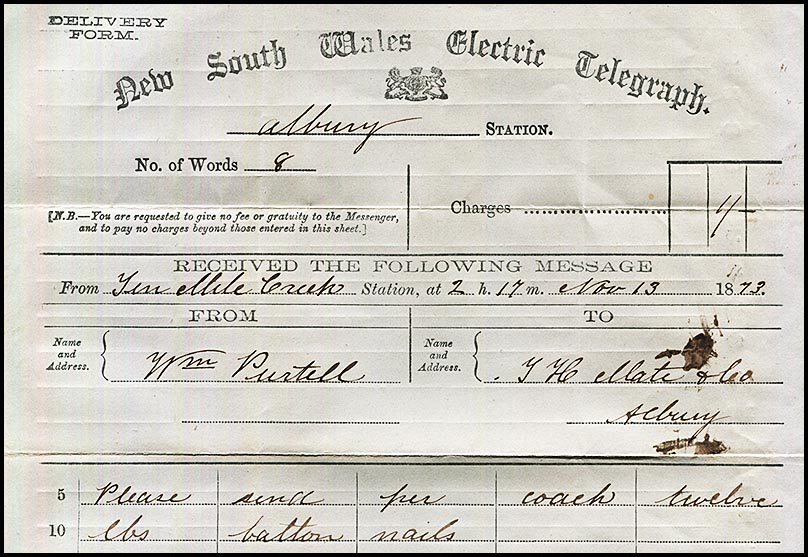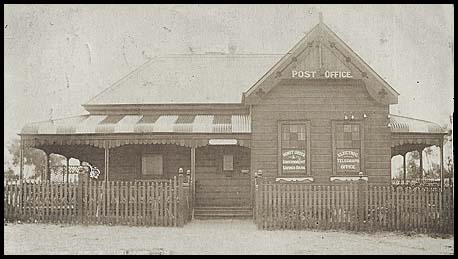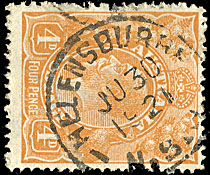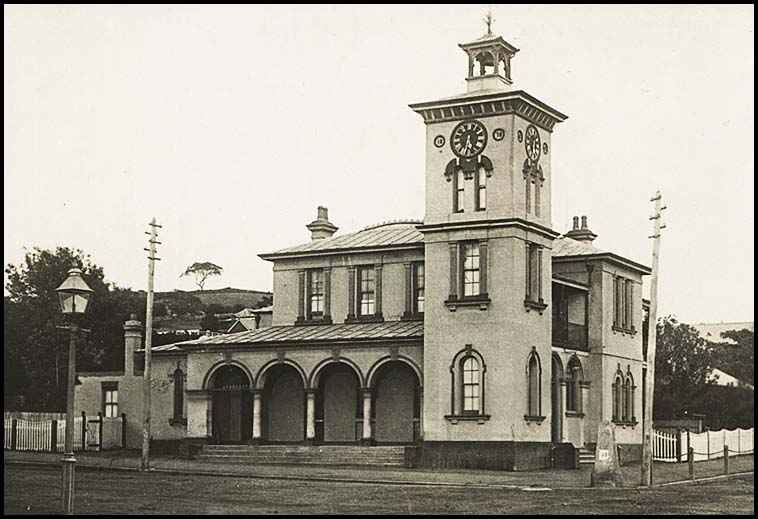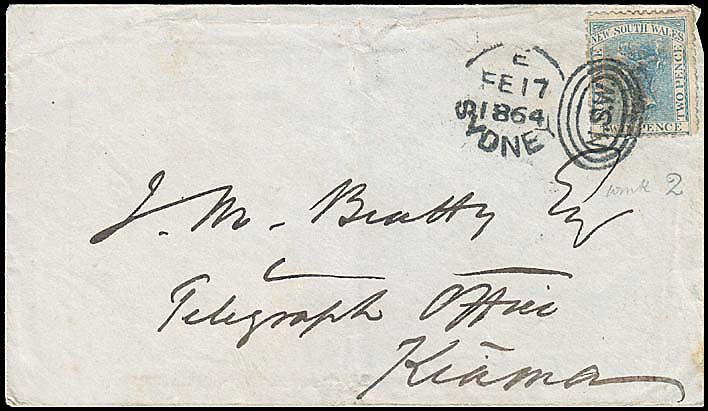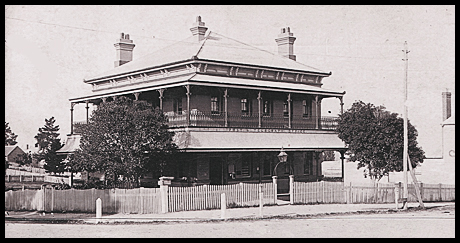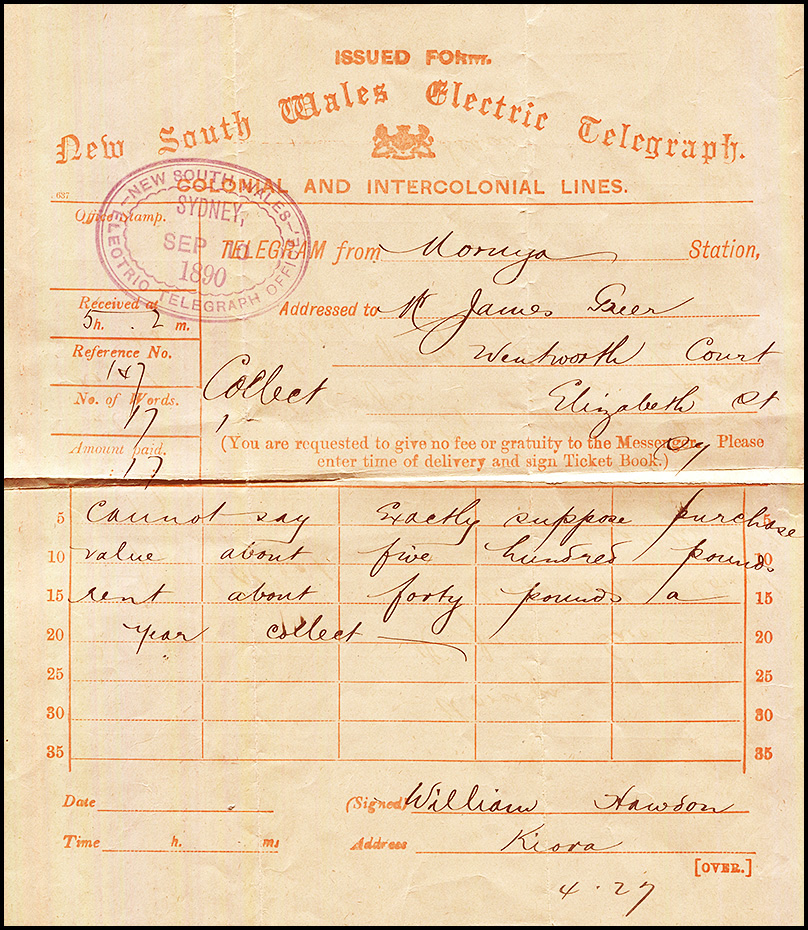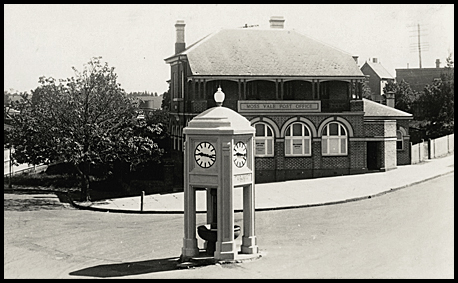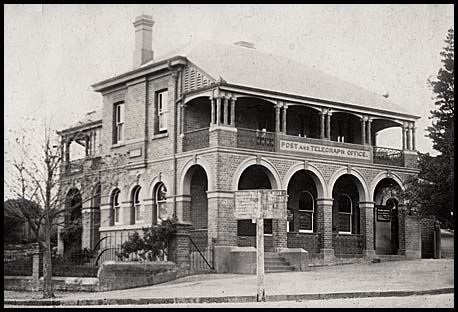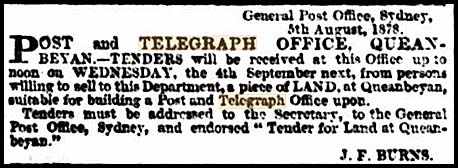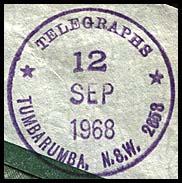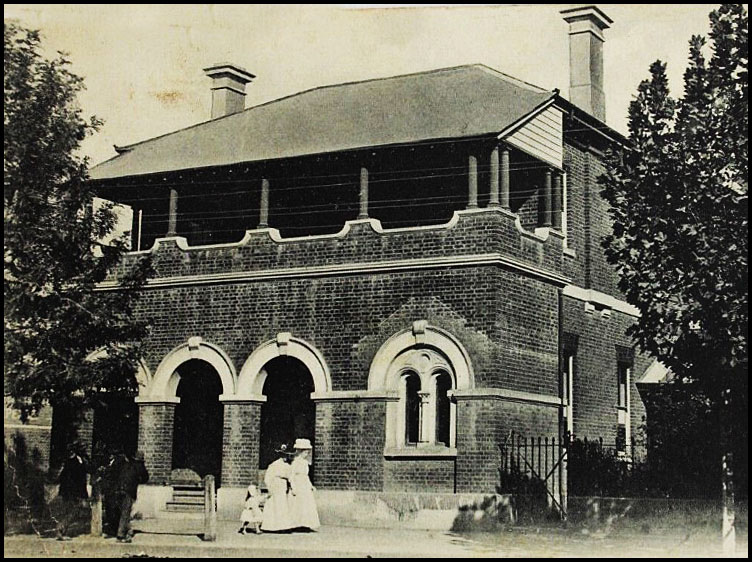Telegraph Offices in the South East region.
- Australia 1901-1988
- New South Wales
- Queensland
- South Australia
- Tasmania
- Victoria
- Western Australia
- International
- Special aspects
The Telegraph Offices constructed in the South East region of NSW are listed in the table below:
|
A Telegraph Office was opened on 10 November 1866. This combined with the Post Office on 1 January 1870. Personnel: April 1865: Mr. George S. Pegus was appointed Soectric Telegraph Station Master. |
|
As of September 1864, tenders were to be called in the Gazette for the erection of a Telegraph Office at Araluen. The building was to be placed at Redbank near the store of Mr. J. H. Blanchford. |
|
Araluen was one of the 29 Telegraph Offices included in the special printings of delivery envelope NC-EO-3. These envelopes incorporated an embossed oval seal (EO6-ET) on the flap of the envelope with NEW SOUTH WALES at the top and ELECTRIC TELEGRAPH at the base. The office name was embossed across the centre of the seal.
|
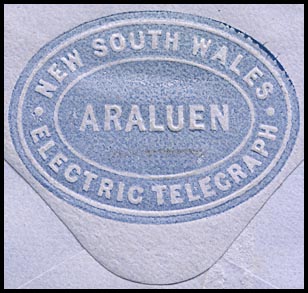 Scan of embossed oval on flap of envelope. Provenance: De La Rue Archives, Gundersen, Johnstone. |
Personnel: April 1865: Mr. George Sidney Pegus was appointed Electric Telegraph Station Master. |
|
|
Bateman's Bay is only 9 km from Nelligen. A Telegraph Office was opened at Bateman's Bay on 29 July 1876 (two years before Nelligen) and it merged with the Post Office on 1 March 1885. |
|
"It may not be generally known that an Electric Telegraph line passes within twelve miles of Bega. The line from Gabo Island is progressing rapidly and will shortly be completed. It is now within a short distance of Eden. Although we have the Electric Telegraph, as it were, passing our very door, yet to the inhabitants of Bega it will be of no practical use or benefit. Considering the irregularity of our mails — and this must, of a necessity, be always the case where we are entirely dependant upon the uncertainty of steamers and the casualties of the sea for the delivery of our letters, etc it would therefore be very desirable that the Telegraph should be extended to the township. The distance is but short and the work inexpensive. The Government will readily accede to the request of the inhabitants if they will guarantee the working expenses of the line - that is, if the cost of messages sent through the wires during the course of twelve months does not cover the working expenses of the line, the inhabitants will be required to make up the difference. So it will just depend upon the use made of the wires whether there will be anything to pay by the people or not We feel quite confident that among the business, people and principal settlers of Bega that the amount required from each individual as a guarantee would be but trifling while the importance of service to be rendered cannot be too highly estimated. We would highly recommend the project to the serious consideration of the inhabitants. As men deeply interested in the fluctuations of the markets the advantages of telegraphic communication with the metropolis is the last importance to them. At the present moment, the latest date from Sydney is ten days old. How any commercial or trading community could rest contented with this unsettled and precarious communication with the metropolis - and a line of Telegraph within 12 miles of them - is a most inexplicable mystery. One would suppose that self-interest would incite activity and energy on the part of our storekeepers and farmers. Surely it requires no very great amount of intellectual perception to see that the interests of the whole community - individually as well as collectively - are concerned. If the inhabitants intend that Bega should advance, progress and prosper, let them connect themselves with the chief market of the colony. let them bring themselves within half an hour's converse with their agents and friends in Sydney. The Electric Telegraph must find a terminus at Bega. The sooner it is accomplished, the greater credit due to the people and the longer it is delayed, the more opprobrium it will reflect upon the members of the community". (The Bega Gazette, 16 May 1868). A Telegraph Office opened in Bega on 20 October 1868. Personnel: October 1868: Mr. James Naylor was appointed as Electric Telegraph Operator at Bega. February 1871: Mr. Samuel Baker was appointed Electric Telegraph Station Master. July 1909: Mr. J. McLaren, the Telegraph Operator at Bombala was transferred to Bega. |
|
In the Gazette of 12 April 1877, tenders were called for the erection of a Post and Telegraph Office at Bombala - closing 17 May 1877. This Office must have been a replacement for the Office used from 15 May 1867 when telegraphic communication began. On 8 June 1871 in the Assembly, Mr. Robertson, in answer to a question from Mr, Hart, replied "from motives of economy, forage allowance had been struck off, and the sum of 10s. 6d. per day had been allowed for horse hire. That arrangement was considered to be an extravagant one by the people of Bombala, and they had petitioned the Government to revert to the old system. The recommendation, however, had not yet been adopted". |
Personnel: April 1867: Mr. J. Burke, Telegraph Station Master at Kiandra was transferred to be Telegraph Station Master at Bombala. June 1888: Mr. Graham previously at Bombala, was appointed the new Post and Telegraph master at Tumut. He passed through Gundagai on 13 June en route for his new home. July 1909: Mr. J. McLaren, the Telegraph Operator at Bombala was transferred to Bega and was replaced by Mr. Cram from Pooncarie. |
Early usage. The earliest indication of a Telegraph Office operating at Bombala is the blue delivery De La Rue Electric Telegraph envelope - probably printed nine years before the Telegraph Office opened. |
Bombala was one of the 29 Telegraph Offices included in the special printings of delivery envelope NC-EO-3. These envelopes incorporated an embossed oval seal (EO6-ET) on the flap of the envelope with NEW SOUTH WALES at the top and ELECTRIC TELEGRAPH at the base. The office name was embossed across the centre of the seal.
|
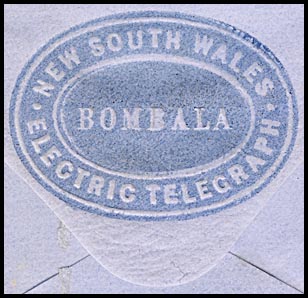 Scan of embossed oval on flap of envelope. Provenance: De La Rue Archives, Gundersen, Johnstone Collection. |
| More substantial evidence for the operation of the Office is a delivery form (NC-DO-9A) sent from Bombala to Hunter Street, Sydney on 23 July 1890. Even so, this form was used 13 years after the Telegraph Office had opened. | |
|
The Telegraph line to Braidwood opened on 24 November 1861. On 26 August 1862, the Gazette announced acceptance of the tender from Mr. John Malcolm to erect a Post and Telegraph Office at Braidwood (presumably the two separate offices within the one building). Personnel: May 1862: Mr Nixon was appointed as Telegraph Station Master but was superseded by Mr. Robins. April 1865: Mr. George U. Hoskings was appointed Junior Operator. June 1866: Mr. Thomas E. Hewit was appointed as Junior Operator in lieu of Mr. Thomas Trader being appointed as Station Master at Jerilderie. 23 February 1868: "On Sunday afternoon last Mr. Buckley, the Telegraph Master, of this town, had a very narrow escape from being drowned. Having had occasion to proceed along the telegraph line to examine it on the previous day, he was returning home and, having no idea that the Shoalhaven had risen to the extent that it had when he came to the river at Warri, he attempted to cross it. No sooner had he got into the strength of the current than the horse was swept off his legs and carried down the stream. Mr. Buckley stuck to the horse - as indeed, not being a swimmer, he had no other recourse - and was carried down the river some little distance when he was drifted within reach of some tea trees in the middle of the stream, to which he hung on and forsook his horse. Fortunately some other travellers came to the river shortly after Mr. Buckley and, discerning his critical position, extricated him therefrom by means of ropes. Had it not been for this timely assistance, Mr. Buckley might have been let to pass the night in his uncomfortable quarters - that is if, in such a case, he had not been swept away by the flood which during the night rose so much higher" (Empire, 26 February 1868). January 1869: Mr. Charles F. Morgan was appointed as a junior operator. 1893 (approx): Mr. H. Curry was transferred after 17 years at Mudgee to Braidwood as Telegraph Master. He remained there for five and a half years. See the Goulburn entry for further details. August 1903: Mr. John C. J. Smith, who had been in charge of the Post and Telegraph Office at Wollombi for 28 years, was transferred to Braidwood. John had joined the service over 40 years before and had been the first operator in Newcastle when the public telegraph office was located in the old railway station. |
Early usage: Braidwood was one of the 29 Telegraph Offices included in the special 1858 printings of delivery envelope NC-EO-3. These envelopes incorporated an embossed oval seal (EO6-ET) on the flap of the envelope with NEW SOUTH WALES at the top and ELECTRIC TELEGRAPH at the base. The office name was embossed across the centre of the seal.
|
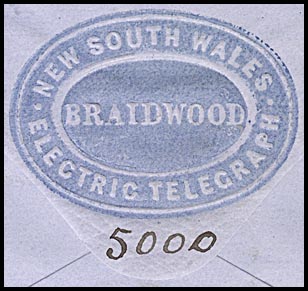 Scan of embossed oval on flap of envelope. Provenance: De La Rue Archives, Gundersen, Johnstone. |
|
The Telegraph Office opened on 1 June 1878. On 1 September 1886, the Post & Telegraph Mistress was Emily Theresa Karara. |
|
The Bega Standard of 11 February 1882 observed "This building will be finished in a few weeks and the business of the Post and Telegraph office will be transferred from 'over the- water'. The building is commodious and well arranged and provision is made for secrecy in the dispatch of telegrams impossible in the cramped lobby of the ridiculous little crib that is thought sufficient for Bega. The contractor, Mr. Taylor, has done his work faithfully". |
|
In the Gazette of 12 April 1877, tenders were called for the erection of a Post and Telegraph Office at Carcoar - closing 24 May 1877. This date was a long time after the Ben Hall incident described elsewhere in this site and refelects on the lack of understanding of the senior Telegraph Department officials on the benefits which could be accrued when telegtaphic communication was made available to special centers. |
|
The Telegraph Office was opened on 7 October 1865 for the despatch of business at 6:30 pm by the Superintendent of Telegraphs. The Telegraph Office merged with the Post Office on 19 November 1868. The Post Office had opened on 1 January 1847. In the Gazette of 25 January 1877, tenders were called for the construction of a Post and Telegraph Office at Cooma. Personnel: The Australian Town and Country Journal of 20 January 1872 reviewed Cooma and included the following:
There is a non-telegraphic account of the Clarke's gang of bushrangers being bad six miles from Cooma after a race day. |
|
Line 1: The adventure which preceeded the opening of the line from Bombala is recounted elsewhere. That led to the first telegram being sent from Eden on 4 June 1868 - one day before the Telegraph Station was opened!! Line 2: The Telegraph line from Bega was opened to Twofold Bay on 21 October 1868. |
Personnel. The Gazette of 16 June 1868 noted the appointment of Mr. Charles Kebby (who had accompanied Mr. Cracknell down from Sydney on the City of Hobart) as Station Master and Line Repairer at Eden. His annual salary as was £200. He accompanied Mr. Cracknell on the City of Hobart on the way to open the Eden Telegraph Station when it broke its main shaft. On 14 July 1881, Charles Kebby died as a result of unimaginable and inhumane treatment. |
Early usage: Eden was one of the 29 Telegraph Offices included in the 1858 special printings of delivery envelope NC-EO-3. These envelopes incorporated an embossed oval seal (EO6-ET) on the flap of the envelope with NEW SOUTH WALES at the top and ELECTRIC TELEGRAPH at the base. The office name was embossed across the centre of the seal.
|
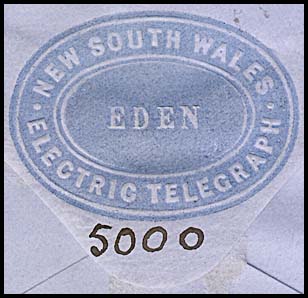 Scan of embossed oval on flap of envelope. Provenance: De La Rue Archives, Gundersen, Johnstone. |
Gabo Island. Gabo Island is an island of about 154 hectacres about 500 m off the coast of Victoria. It is about 14 km east of Mallacoota and near Cape Howe on the border with New South Wales. The first lighthouse was a wooden structure built in 1853. The present Lighthouse structure, made from the island's pink granite, was completed in 1862. On 14 December 1904 control changed from New South Wales to Victoria. The NSW Superintendent's Report for the years 1863-1864 noted "the mode in which the recommendation of the select committee on lighthouses, in 1863, that lines of electric telegraph should be extended to the several lighthouses along the coast, should be carried out. To connect the Gabo Island light, a line from Cooma to Eden, and thence to the island, at a cost of £5,750, would be required". A Telegraph Office was opened at the lighthouse in April 1872 while the island was still under New South Wales jurisdiction. It was reclassified as a Post Office about 1915 but reclassified again back to a Telegraph Office about 1917. The Office was closed on 30 June 1964. A full description of planning and constructing the line from Eden in NSW to the lighthouse and the heartaches and successes of this important outpost is provided elsewhere in this site. It has certainly saved many lives of seafarers over the past 150+ years. Additional material includes:
|
A circular steel date stamp was issued to the Office.
|
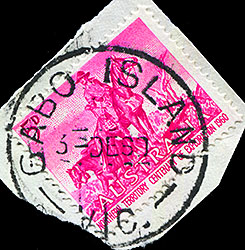 3 December 1960. |
Germanton (Ten Mile Creek) aka Holbrook. A Post Offce had been established at Ten Mile Creek on 1 January 1857. On 13 January 1873, a Post and Telegraph Office was opened. On 1 May 1875, Ten Mile Creek changed name to Germanton. £900 was placed on the Estimates in June 1872 for a Court House and Telegraph Station at Ten Mile Creek. On 17 August 1878, Germanton hosted the earliest known Soccer game in NSW between Germanton and Yarra Yarra. No record of who won. During World War 1, on 24 August 1915, Germanton was renamed Holbrook. |
Early usage. The earliest indication of the operation of the Ten Mile Telegraph Office is a Delivery form NC-DO-3 used for a message transmitted from Ten Mile Creek (later Germanton then Holbrook) to Albury on 13 November 1873. |
|
|
A Telegraph Office was opened on 18 April 1870 although it is not known what the relationship was between this office and the Lighthouse. A great discussion in the Legislative Assembly is contained in the Empire of 29 September 1860. In those days the area was known as Cape St. George but the name was changed in February 1897. In 1905, the office was changed to a telephone and telegraph office. On 12 August 1912, the name was changed to Jervis Bay Heads. |
|
| Kiandra - also see the discussion on the construction of the telegraph line.
The telegraph line to Kiandra was opened on 16 October 1860. A building designed to serve the double purpose of a Post Office and a Telegraph Office was rapidly constructed and was due to be opened in December 1860.. Gibson's Plains was the center of major goldfields in early 1860. About that time, the name was changed to Kiandra - a corruption of the Aboriginal names "Gianderra" meaning "Sharp stones for knives". As the number of people on the gold fields increased dramatically, action was needed for support services. The Sydney Morning Herald of 21 September 1860 reported "Some buildings are being erected at Kiandra under the Colonial Architect's direction. A watch-house and police station have just been commenced and will provide quarters for an inspector of police, a lock-up keeper and six constables. A post office and telegraph station (the duties of both to be performed in one building) is also in progress at Kiandra. Mounted patrol stations at Queanbeyan and Micalago on the road to Kiandra have lately been finished". In addition, a post office was established at Russell's in the vicinity of the gold-fields on the 20th July. On 4 March 1872, the Empire published an article from its correspondent about Kiandra (see also below). In part it noted :"After tea, a stroll to the Post and Telegraph office, a large wooden structure, where at that unofficial hour the courteous official, Mr. J. C. Willans, is in attendance, and obligingly delivers 'good news from home' - which ensures a night's comfortable sleep". BUT - its amazing what can be done with the Telegraph: "The miners of Kiandra have been demanding an extension of their claims, and although the local commissioners had already about doubled the ordinary size, a still larger extension - in fact another doubling of area - has been applied for. This application seems to have been made direct to the Premier instead of through the commissioners and there seems also to have been a reprehensible neglect of what was due to the latter for, instead of a reference to them, there was a telegraphic message to Mr. Charles Cowper junior, a resident J.P., and the son of a Cabinet Minister, to the effect that the claim of the miners would be conceded. Mr. Cowper made this public, thus casting some indirect slur upon the commissioners, by making it appear that they were not, even for the purposes of their own district and their own duties, so much in the confidence of the Government as the individual J.P. alluded to" Although Kiandra was also in the early list, it was discontinued as a Telegraphic Money Order Office on 10 October 1861. |
|
|
|
| Kiandra had a reputation for being really, really cold - and that condition had an effect on telegraphic and postal communication. This condition is reflected in the Tumut and Adelong Times of 20 August 1866:
"Yesterday being Sunday and, after being a week housed up, I resolved to go as far as the town, a distance of a mile along the Tumut Road. After about an hour and a half hard exertions scrambling and sometimes walking on all fours, I reached the city (Kiandra). |
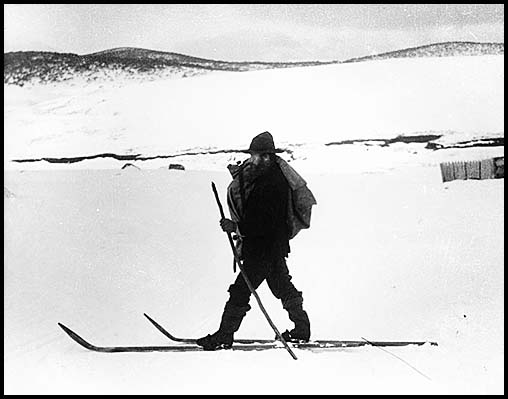 The Mailman arriving at Kiandra. Powerhouse Museum, Public domain, via Wikimedia Commons. |
| I shortly afterwards learned that the Cooma mailman was in a similar fix; the only difference being that the latter was out and could not apparently get in. So we are well fixed; one mailman out and unable to get in, the other in and cannot get out. If it should continue snowing and our mail and telegraph communication cut off from the lower world, we shall begin to think our temporal existence near an end; but it is to be hoped that Providence has it otherwise allotted for us.
As I said before, we are here all of a heap, with provisions sufficient for the whole population for at least six months, and otherwise pretty well prepared to weather the storm; and weather it we will as long as we are able. I may as well state that it has been snowing more or less without intermission exactly a week this day, Monday, and the day is near a close and snowing still. Now for the depth. This I can only guess at. It might be from four to six, eight, and in some places apparently twelve feet". |
|
On 10 April 1861 in the Legislative Assembly, Mr. Weekes explained that the Post Office at Kiandra was put up at a time when it was anticipated that there would be a large population at that place. "Mr. Rotton thought Kiandra had been very much more favoured than other gold-fields. Even at Turon, the oldest and most settled gold-field in the colony, there had not been a post-office put up by the Government. There were 13,000 people, it was said, at Lambing FlatYoung., and there was no Post Office put up there. Even at large towns in the interior, such buildings had not been erected. In fact, the whole £50,000 spent at Kiandra might as well have been thrown into the sea. Mr. Wilson thought the Government were fully justified in spending the money they had done at Kiandra. No place required the erection of a Post Office more than a new gold field for there were no large buildings on them that could be used for the purpose. As to complaining that the Turon had no special Post Office, it should be recollected that the miners in the early days of gold digging were not the settled people they were now, for they only went up there with the expectation of making their pile in a week. Mr. Hoskins bore out the opinions sf the member for Hartley (Mr. Rotton) and wished to know what the Government were going to do with the buildings that so much money had been spent upon at Kiandra. Mr. Arnold hardly knew what buildings the honorable member alluded to. The telegraph office still gave them such returns as quite justified the Government in keeping it open, and as to the expense of keeping open the Post Office, he understood that the gentleman who had charge of the telegraph office proposed shortly taking into partnership a young lady, who could look after the Post Office. As to disposing of the Government buildings now, it would be useless, for there were hardly any persons to purchase them. He had reason to believe, however, that Kiandra would yet prove to be an important gold-field, when all the expense that had been gone to for the place, would prove useful. Mr. Rotton condemned the expenditure at Kiandra but he was a great friend of the gold digger". |
|
An excellent description of Kiandra - especially of its downfall is given in "Kiandra - Unique in Australia's Gold Rush History" - read the first paragraph especially. Another description is given in the Empire of 4 March 1872: "Kiandra, or Giandarra, is 4,600 feet above the level of the sea and it was very cold, even at this season of the year (January), and I noticed on the afternoon of my arrival that gossipers in the street had their hands deeply buried in their pockets and their coats closely buttoned up. The population consists of about 80 Europeans and 150 Chinese. The latter have separate quarters a few hundred yards below the European settlement. There are three stores, three hotels, two or three fruit shops, a school, a Post and Telegraphic office, a police station and a court-house at Kiandra, The 'court-house' is at present used as a barn or stable, judging by the trusses of hay on the floor of the miserable little structure. It appears the Government did not vote sufficient money to finish this building and I am not aware whether a court was ever held in it. The magistrates, by permission, hold their sittings in a room in the police quarters. The provisional school, under the charge of Mr. G. Dale, has an average attendance of twenty pupils. This building is simply disgraceful. The sides are broken in, the windows are smashed, and the doors are without locks or hasps. I should recommend that, in preference, instruction be imparted to the children in the open air. The public houses are Atkinson's 'Empire Hotel', Bourke's 'Kiandra' and Chapman's 'Prince of Wales'. The stores are Atkinson's, Bourke's and Horsburgh's". Kiandra became the birthplace of Australian skiing in 1861 due to the efforts of several Norwegian miners (during the winter of 1860 which probably almost prevented them from prospecting for gold). It is home of the world's oldest Alpine ski club. Until the establishment of nearby Cabramurra in conjunction with the Snowy River Scheme and the construction of the Tumut 1 Power Station in the early 1950s, Kiandra had been Australia's highest inhabited townThe highest are now Charlotte Pass Village in NSW and Dinner Plain in Victoria (near Mt. Hotham). . Personnel: 1 November 1860: Mr. Alexander Tucker to be Station Master at Kiandra Station on his transfer from Hartley as Station Master and Line Inspector. April 1867: Mr. J. Burke, Telegraph Station Master at Kiandra was transferred to be Telegraph Station Master at Bombala.
August 1875: Mr Alfred Edgerton Ambrose to be Station Master. June 1891: Mr. Horace Thurston, a Telegraph Operator in the Head Office was appointed Post and Telegraph Master to replace Mr. Redriff. |
|
|
A Telegraph Office opened at Merimbula on 19 October 1868 by Mr. Cracknell under the guarantee system. Mr. Munn, the Postmaster, was also appointed Telegraph Operator at Merimbula. |
|
Milton was initially the preferred location for a telegraph office over Ulladulla. Milton is 6 km slightly inland and constructing a telegraph line through Milton and so avoiding the difficulties of the water and salt made economic and technical sense. There is some confusion over the date of opening for the Telegraph Office at Milton. Tobin and Hobson state the Post Office opened on 1 January 1860 and that the Telegraph Office opened on 27 April 1875. The Illawarra Mercury however reported the following on 5 November 1861: "A brown snake was killed yesterday, in front of the telegraph office. It first made its appearance at the rear of the telegraph office, when it sprang at one of Messrs. Dickson and Co.'s employees, who narrowly missed being bitten. The man was passing by at the time and did not observe the snake till it flew at him after which it tried to escape and got among some bricks which were in the verandah of the telegraph office. It was then routed out of that spot and disabled by Mr. Aldwell, Station Master, who succeeded in breaking its back, but before it could be dispatched entirely, a dog belonging to Messrs. Dickson and Co. had seized it by the tail, upon which the snake turned around and bit the dog on the nose. The dog immediately relaxed his grasp and did not again attempt to interfere with it. The dog, almost half an hour after he was bitten, dropped down in convulsions, and groaned with agony and reminded in that state for about fifteen minutes, when Mr. John Dickson jnr, treated him to several nobblers of strong rum, which evidently made him inebriated, and no doubt saved his life as he is now, to all appearances, as well as ever. The snake has since been measured, and is found to be four foot six inches in length". Perhaps Mr. Aldwell was Station Master for the Post Office and the community had been informed that a Telegraph Office would be connected shortly. Construction was certainly approaching the area at about that time. When the connection was made, all would join the Dog from Dicksons in celebrating the only way he knew how. - nearly seven years before Ulladulla opened a combined Post and Telegraph Office. Milton Telegraph Office combined with the Post Office on 15 June 1877. |
|
The Telegraph Office opened on 2 April 1883. The Robertson Advocate of 5 August 1902 notes that "the tender of Mr. E. Cochs (£131/10s) has been accepted for alterations and repairs to the Mittagong Poet and Telegraph Office " (actually the article had it correct; the scan by Trove confused the word and I could not bring myself to change it :-). Personnel: March 1883: Mr. A. Prott, Telegraph Operator in the Railway Departmet was transferred to be Station Master at Mittagong. |
| Moruya.
The Telegraph Office was opened on 5 December 1868. Mr. Cracknell had come to open the office and accompany the Postmaster Mr. Egan. Given a range of duties and the tiring trip, Mr. Egan was completely exhausted and unable to do the things he wanted to do on the Saturday morning. So Mr. Cracknell got him moving about midday and they both opened the Moruya Telegraph Office with the affair finishing with three hearty cheers. |
There is a picture of this monstrosity for which, unfortunately, there is no room on this site. |
The Post Office had opened on 1 January 1855. The Post Office merged with the Telegraph Office on 21 January 1875. Before the merger however, the Auctioneers Richardson & Wrench received instructions from the Mortagees to sell by public auction the properties of the late Mr. Oliver Lodge which included "POST-OFFICE, TELEGRAPH OFFICE and DWELLING, in the main street, in the occupation of Mr. H. Lodge, together with 1 Acre of Land, being Lots 14 and 15, Section 19, Town of Moruya". |
|
Personnel: January 1869: Mr Harold Lodge was appointed Telegraph Operator. Later he was also appointed Post Master. And then the situations becomes clouded - see the discussion in the Legislative Assembly on 6 June 1871. Mr. T. C. Lodge (Harold's under-age brother) was appointed Station Master on 1 July 1871. |
|
| Early usage:
The earliest evidence of the operation of the Telegraph Office at Moruya are two delivery forms (NC-DO-9A) . Both forms incorporate the COLLECT annotation and a rare RO7-ETO oval date stamp for Sydney. Other details are:
|
|
|
Nelligen and Bateman's Bay are only 9 km apart. The line to Nelligen from Milton was funded in March 1878. A Telegraph Office was opened on 22 November 1878 (two years after Bateman's Bay) and it amalgamated with the Post Office on 13 October 1879. A Post and Telephone Office commenced operations on 16 July 1908. |
|
The Telegraph Office opened on 1 October 1878. The Post Office had opened in 1860 (as Tumberumba).. On 24 July 1864 the bushranger 'Mad Dog' Morgan shot and killed Sergeant David Maginnity on the road between Tumbarumba and Coppabella. Morgan approached two policemen and shot Maginnity. The other, Trooper Churchley, fled and was later dismissed for cowardice. After the killing the government put a reward of £1000 on Morgan's head. |
|
The office used a rubber circular TELEGRAPHS date stamp (RC1 - T):
|
|
|
"Tumut is dull enough" begins an important article about the route for the Southern line from Sydney to Albury/Wodonga. A Telegraph Station was opened at this place on 11 March 1861. It was probably used only a repeater station to begin with and it used the call sign UN. By 1867, the normally Telegraph Office was operating because the Tumut and Adelong Times of 10 January advised its readers "On and after the 1st of February 1867, the business of our telegraph office will be carried on in the cottage next to the Bee-Hive Hotel, the premises being considered more suitable for the station than those hitherto occupied". Some reports indicate that a combined Post & Telegraph Office was opened by 1870 in the rented Telegraph building. It was more likely that the two Offices were co-located in the rented premises. Other (more likely) reports nominate the amalgamation occurring on 4 September 1876. In the Legislative Assembly on 25 April 1878, it was agreed to provide on the Estimates the sum of £240 for the purchase of a site for the Post and Telegraph Office at Tumut. A combined Post and Telegraph Office was constructed in 1879 and is now of historical and social significance. |
|
Personnel: May 1868: Mr. Edward Long was appointed as Electric Telegraph Station Master and Line Repairer; 1 July 1871: Mr. Kenneth C. McKenzie appointed as Station Master. June 1888: Mr. Graham from Bombala, the new Post and Telegraph master at Tumut, passed through Gundagai on 13 June en route for his new home. |
|
Ulladulla is on the coast with Milton 6 km inland. A Post and Telegraph Office was opened at Ulladulla on 1 January 1882 - about 7 years after Milton.. The Post and Telegraph Office was changed to a Post and Telephone Office on 4 January 1909. |
| Wollongong.
Hopson & Tobin do not list a Telegraph Office as ever opening at Wollongong. The 1863 Report by Cracknell shows that the 58 mile line from Campbelltown to Wollongong and Kiama cost £2,830 8s 2d and that the telegraph line to Wollongong office opened on 11 August 1862. The Illawarra Mercury was informed about 21 March 1862 that "it was the intention of the Telegraph Department to introduce the line about to be brought from Campbelltown into Wollongong town by way of Smith Street and to have the station at the Court House ... We are sorry, however, to differ with it as to the expediency of the proposed line on several grounds ... without some expense being incurred, the Court House will not be available for the uses of an office. There are only two rooms at present attached to the Court House. One of these is used by the Clerk of the Court and as a record office. The other is used as a Magistrates' and Jury's retiring room. Neither of these could be dispensed with. The consequence would be that additional apartments would have to be provided. And all this to secure apartments in perhaps the most inconvenient locality for the public in the town. We would also object to taking any existing premises in any other part of the town, as strongly as fixing the office at the Court House for another reason. We are strongly of opinion that the Post Office and Telegraph Station should be under one roof and under the control of one person who should be an official appointed and held responsible to the Government, and engaged in no other business whatever". A full account can be found elsewhere. |
The Illawarra Mercury of 22 July 1862 carried the following:
A reply has been received from Mr. Rae of the Public Works Department, to the memorial forwarded from certain inhabitants of Wollongong praying that the intention to erect the Post Office and Telegraph Office near the Police Office might be abandoned:
On 8 August 1862, the Illawarra Mercury published the next stage in this saga: "We are given to understand that arrangements have been entered into with the Government for the temporary use, as a Telegraph Station, of the building formerly used as a temporary place of worship by the members of the Church of England, and which immediately adjoins the land on which the Telegraph Station is to be erected. The telegraphic apparatus is expected to arrive in the course of next week and it is confidently anticipated that, within a fortnight, telegraphic communication with the metropolis will be complete". Tenders were called for:
Tenders were ultimately accepted:
Some further explanation is however required here. In the Legislative Assembly of 18 March 1869, Mr Stewart "saw an item of £70 for rent for a Post Office at Wollongong. He knew the building, and he considered the Government were paying too much rent". "Mr. EGAN : I look upon the Wollongong Post Office as a public robbery. The property belonged to a gentleman who was once a member of that House. That gentleman managed to let that building to the Government for a Post Office, another building for police barracks, another for a Telegraph Office and another for some other purpose, and besides that he managed to become a contractor for some public works. After he ceased to be a Member of that House, he took several navvies down to Wollongong and they occupied a room in the building used for a Post Office. The Postmaster complained that there was only a wooden partition between the room occupied by the navvies and the Post Office. The navvies went away, the room was let to the Government, and £40 a year added to the rent making it £70. The Government had built a Telegraph Office, but had never found time to build a Post Office, although it only required one room to be added to the Telegraph Office for that purpose. He, last year, moved the reduction of the item from £70 to £30; but he was induced to withdraw the motion, by a premise made by the Postmaster-General that he would make inquiries into the matter. But he saw the item of £70 still in the schedule, and he proposed to reduce it to £30". A description of Wollongong carried the following in the Sydney Morning Herald of 9 September 1873: "Proceeding from the wharf to the town, two fine hotels will be passed One of them - the Queen's - is, for a country town, an immense establishment, Close to the "Queen's stands the Post and Telegraph office, in care of Mr Mackel. A flagstaff had time-ball front this office, considered as a building one of the neatest along the coast. From this point, a turn to the left leads to the principal street which runs east and west, a fine wide thoroughfare, well made, with some excellent edifices at each side". See also the need for a horse at Wollongong elsewhere. Personnel: June 1866: Capt. Scott was appointed as Telegraph Line Inspector. March 1890: Mr James Vincent O'Brien was appointed Telegraph Operator. |
Two formats for a rubber circular TELEGRAPH OFFICE date stamp are known:
|
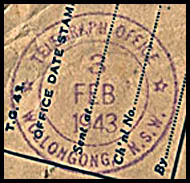 3 February 1943. |
|
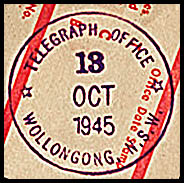 13 October 1945. |
| The only TELEGRAPH slogan cancellation recorded as having been used at Wollongong of the ten slogans made available throughout Australia is SEND A TELEGRAM.
Unfortunately the only recorded example has a double impression of SEND A TELEGRAM and COM'TH ELECTIONS/VOTING/COMPULSORY.
|
 |
